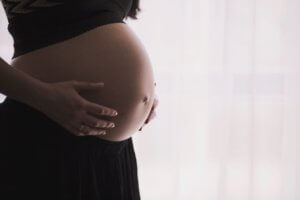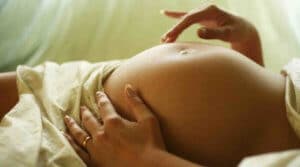What does it mean when the midwife talks about a stargazer during the examination? The SL position, which is the abbreviation for the position of your child with the head down, is good at first.
A breech presentation or transverse presentation would not be so pleasant during birth. Stargazer means that your child is lying head down in your pelvis.
It is rarely known exactly why a child lies “upside down” in its mother’s womb. Some reasons can be determined at birth, for other children there is simply no explanation.
The birth of a stargazer can have consequences, for you and for your child. We explain what you need to know about the birth, why exactly we talk about a stargazer, and what the anterior placenta is all about.
Table of contents
Stargazer: What Does It Mean?
How long a birth takes, how strenuous it is, and whether medical intervention is needed depends on many factors. One factor is the head circumference from the baby, another factor is the position.
Infant position SL, i.e. the position with the skull down, is desirable. But that is not all. Ideally, your baby should lie face down. From this position, it can slide through the birth canal more easily.
But sometimes children do not lie in an ideal position. If the skull is down, but the face is facing forward, this is called a stargazer.
Even in this case, experienced midwives can accompany the child safely into the world.
Term Stargazer Is Misleading
In recent decades, the birth of a child has been increasingly stylized as a medical emergency. Births usually take place in hospitals and under professional medical supervision.
Anything that in any way does not conform to the norm is treated with medical intervention. In this context, experts speak of a pathologization of birth.
In order for doctors to have optimal access and to be able to help promptly, women like to be placed on their backs during childbirth. This position has advantages when it comes to medical interventions.
For birth, this means the following: Normally, the baby is born head first, with the little nose facing the mother’s anus. If the child position SL is given, this is how it should be.
This allows the baby to push its head through the birth canal quite easily. The child’s chin rests on the chest until the head is already sticking out.
Then the child pushes the head up, and the entire length of the cranium “slides” out.
Only then the shoulders are turned by the mother’s pelvis. The shoulders are not born at the same time but are slightly offset. The rest of your baby will then be born very easily.
This position with the little nose to the back is optimal, because the shape of your child’s skull can thus slowly and relatively gently stretch the birth canal.
The shoulders slide down so that the “widest” parts of your child do good preliminary work. If your child is a stargazer, it looks different. Then it lies in the pelvis in such a way that the nose points to your belly button at birth.
Your child will therefore lie in the pelvis rotated by 180°. The baby’s head circumference will be larger for the birth. This is because your child cannot simply push itself out by stretching its neck.
The stretching would not clear the way for him, but only presses on your rectum. Therefore, a stargazer birth is more strenuous, requires more strength and time.
The baby’s head must be pushed completely through the birth canal. So when you lie on your back at birth, your little stargazer won’t be the first to see the sheets on the bed below you.
Instead, he will look up at the ceiling when the little head is born. Now imagine that the ceiling of the delivery room is glass and consider that most children come into the world at night time.
Stargazer: This Is How The Birth Goes
If your child is not optimally positioned in the pelvis at the time of birth, the cervix and birth canal will not be stretched slowly and gently. Instead, you will have the feeling that you have to actively push your child out at an early stage.
This in turn results in injuries. A perineal tear often cannot be avoided in a stargazer, and sometimes there are further tears in the labia, clitoris and vagina.
So when you hear and read about late effects from a stargazer, this is exactly what is meant. However, an experienced midwife can competently manage a stargazer birth and avoid damage and consequences.
Of course, you do not have to give birth to your child lying on your back. With a stargazer this is even rather bad.
In this position, you have to push your child out through the birth canal against the force of gravity – this costs energy and is unnecessarily strenuous.
Midwives generally recommend giving birth in the lateral position, standing or squatting, possibly also in the quadruped position. With the exception of the lateral position, you can use gravity in all positions to make it easier for your child to get out.
With a stargazer, there are even more options. For example, if you lie asymmetrically in the quadruped position or in the squat position, i.e. stretch one leg out to the side, the birth canal becomes even wider.
There is then plenty of room for the baby’s larger head circumference, and the birth goes faster.
Consequences For The Baby?
Under certain circumstances, your baby can also suffer injuries during birth from the stargazer position. Sometimes such a birth takes too long so that your baby becomes too weak.
If the umbilical cord is too short, complications can arise. Giving birth in a hospital ensures that the doctors take competent care of you and your child. Your child will then be helped into the world – usually with a suction cup or forceps.
This sounds terrible, but it is actually not such a big deal: Both devices can be carefully applied to your child’s skull. With little force and a lot of sensitivity, your child’s head is gently directed toward the vaginal opening, so that your child is born more quickly.
This is always necessary if a large head circumference of the baby slows down the birth enormously. Late effects are very, very rare.
In some cases, your child may suffer slight sprains in the area of the rib cage and spine, because the stargazer birth is a different feat. In this case, an osteopath can help your child, who is rather restless after such a birth, to get some rest.
However, your child will not suffer any long-term damage. The osteopath will only relieve tensions and blockages caused by the slow progress of the birth.
This does not hurt the child, but provides relief.
Doing The Groundwork: Stargazers Sometimes Still Turn
Even if it is not always clear why your baby wants to come into the world as a stargazer: You can help him to turn.
If you circle your pelvis shortly before birth, your baby may feel like turning into the usual position. Midwives know other movements and hand grips that can even move a stargazer into the ideal position during birth.
However, this is not always effective. The decisive factor is why your baby has moved into this position.
Interventions At Birth?
A stargazer is usually not a reason for a cesarean section. However, due to the larger circumference of the baby’s head, an episiotomy may be advised.
If the birth process is too strenuous for the mother or takes too long for the baby, a suction cup or forceps are sometimes used.
This is then noted in the maternity record as “vaginal surgery”. However, all this does not have to be the case – many stargazers are born naturally with a little more patience and strength.
Anterior Placenta, Too Short Umbilical Cord, fibroids: Why Do Children Become Stargazers?
It is not known with every child why it does not move into the ideal position. However, the reason can often be determined at birth. Many stargazers are diagnosed with an anterior placenta.
This means that the placenta is attached to the anterior wall of the uterus. If there is no anterior wall placenta, an umbilical cord that is too short may be the reason why your baby does not want to turn properly.
Some women also suffer from fibroids. These are small growths in the abdomen that probably also put the baby in the stargazer position.
However, children are also in the stargazer position if there is no anterior placenta or other medical reason detectable.
Many women today have sedentary jobs. They are in the office for eight hours and do not move much. At home, the sofa and armchair are tempting.
This seating furniture, like the office chair, entices people to sit with their shoulders slouched and against the hollow back. This slightly forward-tilted position with the pelvis tilted backward doesn’t give the child much room in the abdomen.
It is thought that this forces children into the stargazing position. And this is true even if there is no anterior wall placenta to cause space problems.
Sitting with legs crossed can also constrict the abdominal space.
When Do Babies Turn?
Normally, babies are thought to get into the right position about four weeks before birth. About 90% of babies have already moved into the optimal position by the 36th week of pregnancy.
However, you should not worry at first if your baby does not do this. Some babies remain in the squatting position until the 37th or even 38th week of pregnancy.
They then turn just before birth. By the way, well-trained midwives can show your child when and how to turn using certain hand movements. And this can be done even shortly before birth.
So it’s clear that there is no universal answer to the question “When do babies turn?” Just because most children do this in the 36th week, your baby does not have to do the same.
By the way, the week of pregnancy can be determined by measuring the size of your baby. This can be done during an ultrasound examination. But midwives can also do this by palpating the abdomen.
The length of your baby’s skull is less important than the circumference of the baby’s head, the total length and the estimated weight.
Sources
https://www.rtl.de/cms/vorderwandplazenta-was-ist-das-und-welche-risiken-kommen-damit-4124705.html
https://www.familie.de/schwangerschaft/vorderwandplazenta-was-bedeutet-das-fuer-mutter-und-kind/












